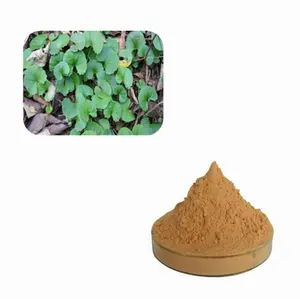Dihydromyricetin, also known as glucoside, is a flavanol, a type of flavonoid. It is found in Japanese vines,
mold leaves and hairy vines; Lianxiang; Citrus aurantium; Rhododendron cinnabarinum;
some species of the genus Pinus; some plants of the cedar genus, and the genus.
Licorice has been used in traditional Chinese medicine to treat fever, parasitic infections,
as a laxative, liver disease treatment, and as a hangover treatment.
A method for large-scale extraction of vine grape extract from vine grape extract was established.
In a trial of 60 patients with fatty liver, dihydromyricetin improved sugar and lipid metabolism and played an anti-inflammatory effect, which is beneficial.
Specification
| Product Name: | Dihydromyricetin | CAS No: | 27200-12-0 |
| Source: | Ampelopsis grossedentata (Hand-Mazz)W.T.wang | Part Used: | Leaf |
| ITEM | SPECIFICATION | TEST METHOD |
| Active Ingredeints | ||
| Dihydromyricetin | NLT 98% | HPLC |
| Physical Control | ||
| Identification | Positive | TLC |
| Appearance | White powder | Visual |
| Odor | Characteristic | Organoleptic |
| Taste | Characteristic | Organoleptic |
| Sieve Analysis | 100% pass 80 mesh | 80 Mesh Screen |
| Moisture Content | NMT 1.0% | Mettler toledo hb43-s |
| Chemical Control | ||
| Arsenic (As) | NMT 2ppm | Atomic Absorption |
| Cadmium(Cd) | NMT 1ppm | Atomic Absorption |
| Lead (Pb) | NMT 3ppm | Atomic Absorption |
| Mercury(Hg) | NMT 0.1ppm | Atomic Absorption |
| Heavy Metals | 10ppm Max | Atomic Absorption |
| Microbiological Control | ||
| Total Plate Count | 10000cfu/ml Max | AOAC/Petrifilm |
| Salmonella | Negative in 10 g | AOAC/Neogen Elisa |
| Yeast & Mold | 1000cfu/g Max | AOAC/Petrifilm |
| E.Coli | Negative in 1g | AOAC/Petrifilm |
| Staphlococcus Aureus | Negative | CP2015 |
Function
1. Scavenging free radicals, anti-oxidation
2. Antibacterial effect and anti-inflammatory
3. Lower blood sugar and blood lipid levels
4. Anti-tumor
5. Anti-thrombus
6. Protect the liver and inhibit liver fibrosis
7. Eliminate the effects of alcohol




Reviews
There are no reviews yet.